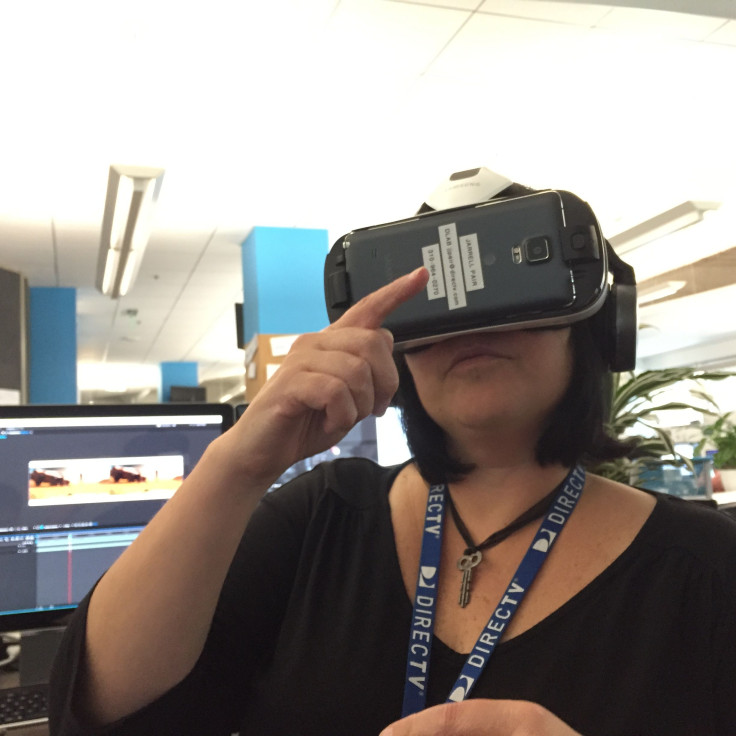DirecTV Experiments With Oculus, Samsung Gear And A Fridge That Tells You What Gordon Ramsay Show To Watch

AUSTIN, Texas -- Pay-TV companies aren't particularly known for innovation, even the ones that launch satellites and beam TV signals to space and back. DirecTV is hoping to change this by bringing its research lab to the south side of Austin and throwing open the doors to designers and engineers flocking here for South by Southwest.
For DirecTV, the future includes: NFL games in virtual reality, a lamp that can turn a coffee table into an interactive screen, and a refrigerator that suggests what cooking show you should be watching. Some of the projects had the taped-together feel of a high school science project; others looked pretty ready for prime time.
The audience here at SXSW isn't potential DirecTV subscribers; it's designers and engineers, who DirecTV would like to lure to its headquarters in El Segundo, California. "Our primary objective here is less brand and more recruiting," said Senior Vice President Tony Gonsalves. "This is a hotbed for young designers, young coders, so we're trying to build a little excitement around a fairly traditional company."
So DirecTV let its engineers -- hackers, really -- out of the lab, gave them Lone Star beers and smoky brisket sandwiches, and let them show off what they've been working on.
Drawing the most attention were two virtual reality demonstrations, one with a product available today -- Samsung Gear -- and one with Oculus Rift prototypes. Samsung Gear VR goggles are available today for $199 and basically serve as a holster for a Samsung Note 4 on your face. Oculus is a higher-quality VR experience, but that company, acquired by Facebook in a $1.2 billion deal last year, hasn't shipped anything to consumers yet.
Will people watch DirecTV through VR goggles? Probably. "We're trying to take the entertainment experience a little farther out," Gonsalves said. "No one is really sure how that is going to manifest."
The Samsung goggles showed a demo of what it might be like to watch a 3D movie inside a simulated movie theater. Then it showed a demonstration of an NFL game where you're sitting in a seat at the stadium. Gonsalves said perhaps people will be able to choose their seat (50-yard line or Jerry Jones' luxury box?) for those looking for an almost-there experience. Where this starts to get interesting is when DirecTV, soon to be acquired by AT&T if the feds permit it, pipes TV directly to the phone, and into the heads of subscribers wearing these goggles.
The Oculus goggles were even more immersive. Using PlayStation controllers, viewers were allowed to walk around what looked like a Tuscan villa with huge screens placed in the gardens and in several rooms. The perception of movement is so real, it can generate seasickness for the unacclimated. While the scenario was contrived, Gonsalves said it could be applied to, say, a travel show that could actually take viewers to Tuscany or anywhere else.
From there, the experiments got a bit more far out and rough around the edges. One engineer, Harry Porudominsky, built a cardboard representation of a refrigerator, which had sensors to tell what kind of food was inside. The TV could then recommend the Gordon Ramsay show that demonstrated recipes with those ingredients.
Another had "kluged-together" -- Gonsalves' description -- a lamp that projected interactive screens on a wood tabletop. The idea here is that projectors have become small and powerful enough to be integrated into everyday household items and used to project video, images or games onto random surfaces in the house. This particular coffee table turns on when you set a can of beer on it.
None of these are today or even this-year products, but all represent various potential futures for an industry undergoing radical transformation. As far-fetched as TV service on your phone seems today, AT&T and Verizon are busy acquiring the spectrum to make that feasible. With the likes of Apple and Sony getting into the TV business, and competing with DirecTV, the video landscape is going to look entirely different this time next year. Even the TV part of "TV" could go away, leaving us with projectors on coffee tables or VR goggles. Stay tuned.
© Copyright IBTimes 2024. All rights reserved.






















